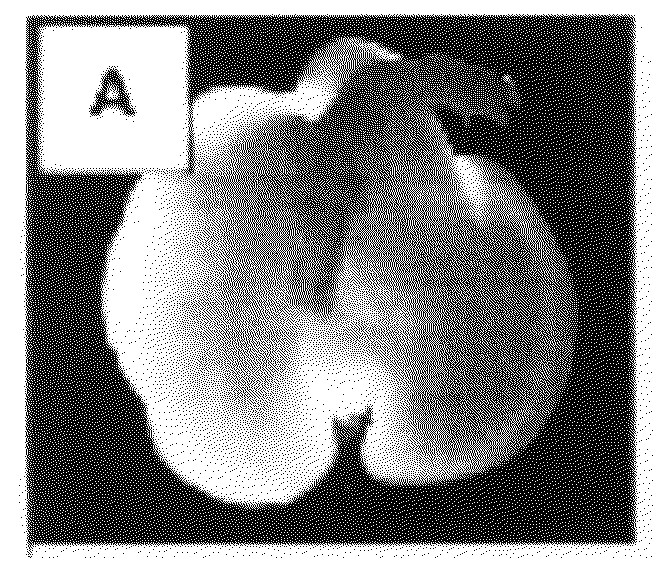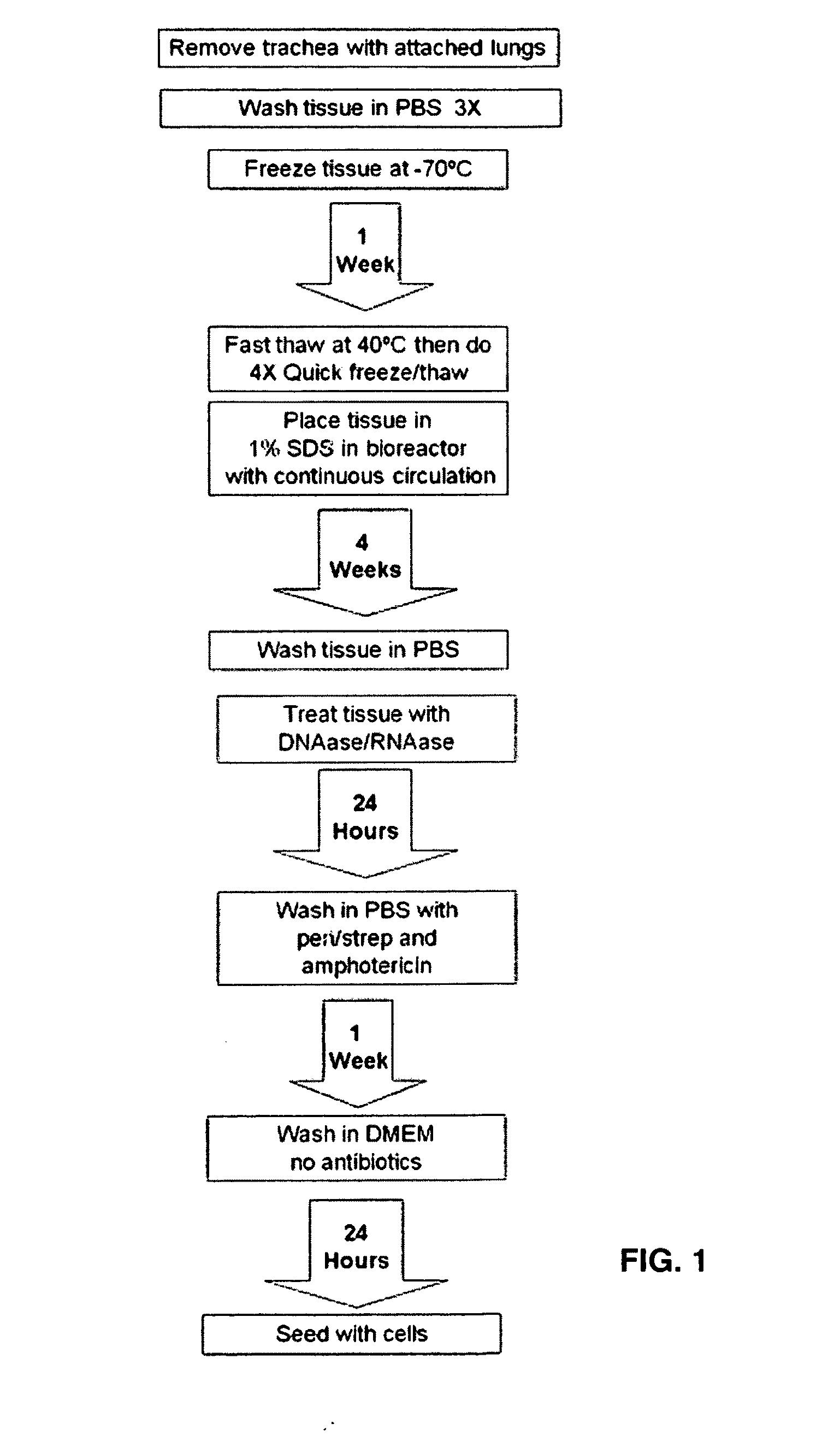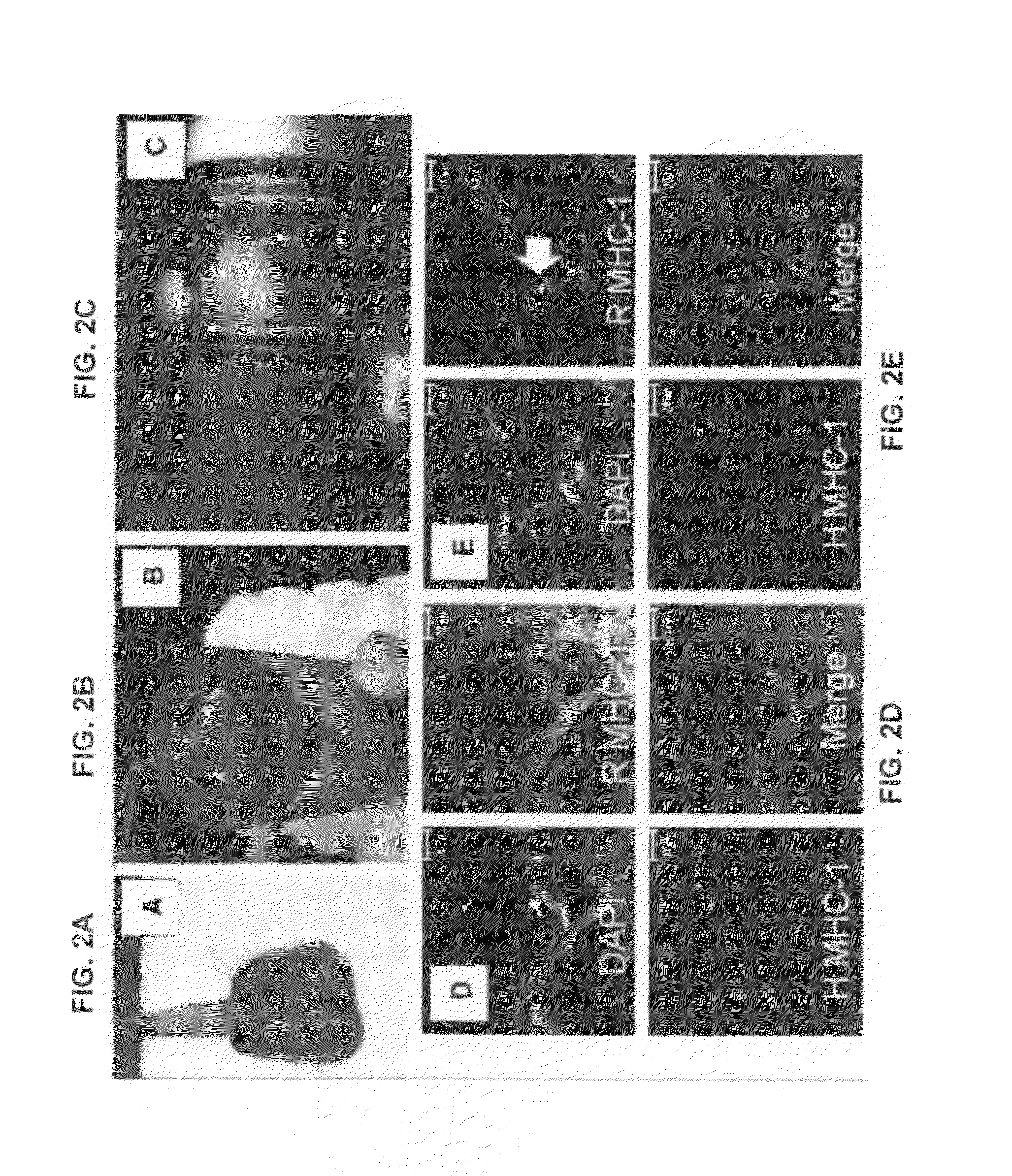Production of and uses for decellularized lung tissue
a technology of lung tissue and decellularization, which is applied in the field of decellularization process of lung tissue and the production of engineered functional lung tissue, can solve the problems of lack of available organs, burden on health care system, and high cost burden of associated healthcare utilization and expenditures
- Summary
- Abstract
- Description
- Claims
- Application Information
AI Technical Summary
Benefits of technology
Problems solved by technology
Method used
Image
Examples
example 1
Tissue Decellularization Procedure
[0042]To develop the decellularization procedure, 96 sets of rat trachea with attached lungs were excised and cell membranes and nuclear material were removed using a process which combined freezing, enzymatic digestion and detergent treatment (FIG. 1). Whole trachea, esophagus and lungs were excised and tissues were cleaned to remove attached esophageal, lymphatic and connective tissues before lungs were weighed and photographed. Lungs were stored at −70° C. until decellularization was initiated. Lungs were later thawed in a 40° C. water bath and were flash frozen on dry ice followed by quick thawing, a process which was repeated four times, to enhance cell damage and facilitate cell loss. 3 mls of 2% sodium dodecyl sulfate (SDS) (Sigma, St. Louis, Mo.) was then injected into the trachea and into the right and left bronchus prior to placing the lungs into a 50 ml chamber of a rotating bioreactor (Synthecon, Houston, Tex.) containing 1% SDS for 1, 2...
example 2
Process for Decellularization of Lung Tissue
[0060]Decellularization of lung tissue utilizes a combination of physical (freezing), mechanical (rotary bioreactor with re-circulating fluidics) and enzymatic (DNAase and RNAase treatment) steps to produce DC-lung that was free of cellular material, remnants of nuclei or nuclear material (FIG. 1). It is contemplated that sonication also may be utilized, and may be more effective, to remove cellular material and compare it to the freeze-thaw method described herein. Sonication may cause less damage to the ECM and allow for better retention of collagen. Also, it is contemplated that peracetic acid (PAA) may be used instead of a detergent-based, e.g., sodium dodecyl sulfate, in the decellularization process.
[0061]It was determined that lungs could be fully decellularized without destroying the underlying extracellular matrix (ECM). The trachea, esophagus and lungs were removed together and the excised tissues were later cleaned to remove att...
example 3
Evaluation of Stem Cell Attachment in DC Lung
[0065]To evaluate the ability of DC lung to support attachment and survival of cells DC lung was compared to matrices that have been shown to support development of lung tissue such as Matrigel and Gelfoam. A Collagen I / PF-127 hydrogel matrix which produced 3D fiber formations that were similar to what we saw in the DC lung (FIG. 1N-Q). The influence of composition and stiffness of matrices has been shown to be important to support of a number of biological processes as well as to significantly influence cell differentiation and tissue development.
[0066]The ability of human endogenous stem cells, Oct-4+ SSEA-1+ murine embryonic stem cells and fetal lung cells to populate DC lung, collagen-1 / PF127 hydrogel matrix, Matrigel and Gelfoam and to survive after 1 week of culture was examined. mESCs populated the DC lung matrix very well and cells were found throughout each 1 mm portion of matrix (FIG. 4D). Cells did not populate the other matric...
PUM
 Login to View More
Login to View More Abstract
Description
Claims
Application Information
 Login to View More
Login to View More - R&D
- Intellectual Property
- Life Sciences
- Materials
- Tech Scout
- Unparalleled Data Quality
- Higher Quality Content
- 60% Fewer Hallucinations
Browse by: Latest US Patents, China's latest patents, Technical Efficacy Thesaurus, Application Domain, Technology Topic, Popular Technical Reports.
© 2025 PatSnap. All rights reserved.Legal|Privacy policy|Modern Slavery Act Transparency Statement|Sitemap|About US| Contact US: help@patsnap.com



